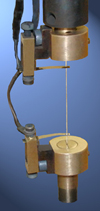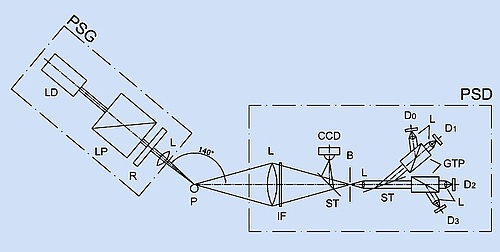Using subsecond pulse heating techniques it is possible to reach temperature regions that are not accessible to steady state experiments, which are limited to temperatures below about 2000 K. This limitation is a result of chemical interaction of the specimens with the containers, the loss of mechanical strength, problems with heat transfer, evaporation and electrical insulation while the sample and its environment are kept at such high temperatures. Fast dynamic methods have been developed to avoid these difficulties by heating up the specimen in a very short time to the liquid state while the sample keeps its cylindrical shape because of inertia. In this way it is possible to extend the measurements to higher temperatures and determine thermophysical properties of metals from temperatures of about 1500 K up to more than 5000 K.
Wire shaped specimens (0.5 mm diameter, 50 mm length) were resistively self-heated by a nearly rectangular current pulse of 10 kA supplied by a high voltage capacitor discharge circuit. Melting is reached in less than 30 µs and heating continues up into the liquid phase. Due to the short timescale, gravitational forces do not distort the geometry of the specimen even in the liquid phase. Time resolved, with sub-µs resolution, the following quantities have been measured: voltage drop along a defined inner part of the specimen as well as current through it, and the surface temperature radiation. Additionally pictures of the specimen have been taken at various instants by a high speed CCD framing camera. These measurements allow the determination of heat capacity and the mutual dependencies between enthalpy, electrical resistivity, temperature, and density in the high-temperature solid and in the liquid phase. Thermal conductivity can be estimated from resistivity data using the Wiedemann - Franz - law.
Measurements of properties of matter at high temperatures are useful for many reasons:
They are required for high temperature technologies (i) to model liquid metal processing operations such as casting and welding e. g. input data for numerical simulations, (ii) to understand, simulate and design new processing equipment such as facilities for the growth of silicon single crystals from the melt, (iii) for obtaining phase diagrams, (iv) for obtaining temperature reference points, (v) for accurate assessment of potential accidents in the design of safe nuclear reactors, (vi) for aerospace techniques, and (vii) for basic therory such as critical points of metals, which require high temperature and high pressure conditions.
They are required for high temperature technologies (i) to model liquid metal processing operations such as casting and welding e. g. input data for numerical simulations, (ii) to understand, simulate and design new processing equipment such as facilities for the growth of silicon single crystals from the melt, (iii) for obtaining phase diagrams, (iv) for obtaining temperature reference points, (v) for accurate assessment of potential accidents in the design of safe nuclear reactors, (vi) for aerospace techniques, and (vii) for basic therory such as critical points of metals, which require high temperature and high pressure conditions.

